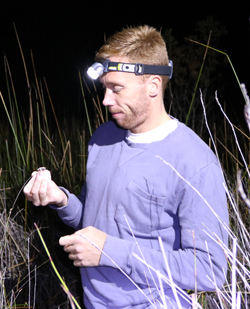Unlikely urban frog discovery surprises scientists
A University of Newcastle (UON) biologist has made the incredible discovery of a new frog species nearby Newcastle Airport, Australia.
Discoveries of new vertebrate species are rare, typically occurring in isolated and poorly explored areas – making this discovery within a populated and well-developed city so unlikely.
It was the frog’s unique ventral pigment or ‘marbled underbelly’ that led Dr Simon Clulow to know instantly that he was holding something unfamiliar to the world of science.
 “The distinctive marble pattern on the frog’s belly, along with other features makes it quite different to any other frog species in this part of the world and led us to believe straight away that we had found a new species - it was an incredible moment,” said Dr Clulow.
“The distinctive marble pattern on the frog’s belly, along with other features makes it quite different to any other frog species in this part of the world and led us to believe straight away that we had found a new species - it was an incredible moment,” said Dr Clulow.
“Nowadays many new discoveries are based primarily on genetics, that is the frogs look similar to other known species but when we analyse them in the lab we find they differ genetically. It’s almost unheard of to pick up a vertebrate in the field and know instantly, based on appearance alone, that it is a new species,” said Dr Clulow.
Scarcely bigger than a human fingertip and living well concealed under a layer of vegetation or sand, it’s little wonder they have avoided discovery.
Dr Clulow said the frogs were ‘cryptic’, that is they visually mimic their natural surroundings to avoid detection - a natural defence mechanism particularly common in small lizards, snakes and frogs.
“They are highly secretive. Individuals remain well camouflaged and hidden under grass, leaves and sand and are often found only by following the male advertisement or ‘mating’ call,” said Dr Clulow.
A striking orange ‘flash colour’ is visible in its groin when the frog extends its legs - another important defence mechanism.
“If a predator comes across the frog, the frog will flash a brilliant burst of orange as it attempts to leap to safety. This is thought to momentarily startle the predator, helping the frog to survive another day!” said Dr Clulow.
Dubbed Mahony’s Toadlet (Uperoleia mahonyi), the name honours Dr Clulow’s supervisor and mentor, Professor Michael Mahony, a renowned frog expert and conservationist.
“Professor Mahony has dedicated his life to the research and conservation of frogs, this is a wonderful opportunity to acknowledge his very meaningful work,” said Dr Clulow.
Not to be confused with a toad, Mahony’s Toadlet is a native Australian frog species which takes its common name from the glands on its back which superficially resemble the toads of Europe and the Americas.
The advertisement or ‘mating’ call is a single audible ‘squelch’ sound lasting less than one second.
The species was discovered at Oyster Cove in Port Stephens and has a highly restricted distribution, occurring in select coastal sand swamps in the Myall Lakes, Port Stephens and Central Coast.
“The frog is a habitat specialist, living exclusively on a particular type of leached white sand substrate, which could make it more at risk from threats such as habitat loss and sand mining.”
“Coastal areas such as those inhabited by this new species are also highly attractive residential development locations. Sadly, this threat, combined with the limited distribution of the frog could result in it being immediately listed as a threatened species,” said Dr Clulow.
This discovery was detailed by Dr Simon Clulow from the University of Newcastle along with coauthors Dr Marion Anstis (University of Newcastle), Prof Scott Keogh (Australian National University) and Dr Renee Catullo (University of Western Sydney) in the journal Zootaxa, published today.
Related news
- Innovative ideas awarded $3.8m in NHMRC research grants
- Former Australian Prime Minister honoured at University of Newcastle graduations
- Advancing Human-Agent Collaboration Through Agentic AI
- Breaking barriers: First doctors graduate from equity pathway
- Translating compassion: a linguist's commitment to social inclusion
The University of Newcastle acknowledges the traditional custodians of the lands within our footprint areas: Awabakal, Darkinjung, Biripai, Worimi, Wonnarua, and Eora Nations. We also pay respect to the wisdom of our Elders past and present.